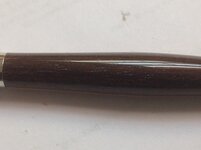I have the same problem!
I apologize for butting in, and I hope this isn't considering hijacking the thread, but I was going to post exactly the same problem. Also, I apologize in advance because this will be a long post.
I have just begun pen turning, and my first pens, even two out of walnut were glass smooth and without blemish. The last two, done with the same procedure, but with two perhaps significant differences, were marred by small white blemishes in the grain. I have posted a picture below.
The two differences since my initial turnings are the type of CA (my problems began when I started using Stick Fast instant CA adhesive I purchased at Woodcraft) and when I started putting that CA glue in the refrigerator.
My procedure in brief is as follows:
Turn to shape and size
Sand with 100, then 220, then 400
Clean with acetone
With lathe at slow speed, apply a couple of coats of thin CA, using aerosol accelerant sparsely each time.
Still with the lathe turning slowly, apply 4 or 5 coats of medium CA, with accelerant after each coat.
Sand with 400 until there are no low spots, and an even sandy finish is uniformly across the pen
Wet sand carefully with mico mesh going through 1500 to 12000.
Your thoughts and critiques are most welcome. I have to say that I think it is either the CA glue itself or putting it in the fridge, because this same procedure yielded absolutely stunning results before. It is only evident in my walnut turnings; my cherry or quilted maple seem just as before.
I plan on trying one more time doing two things differently; the CA glue is at room temperature, and i will, in addition to cleaning carefully with acetone, also blow the blank off then vacuum the blank before applying the CA. I will let you know how it turns out.
Thank you again, and I hope since the original poster has what seemed to be the same issue, I can be excused for posting on his thread.

